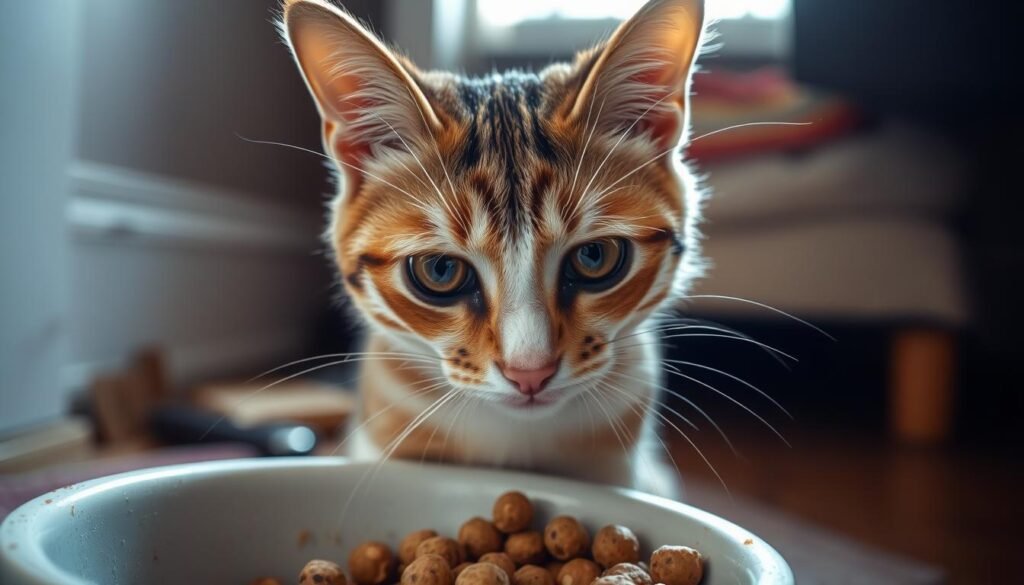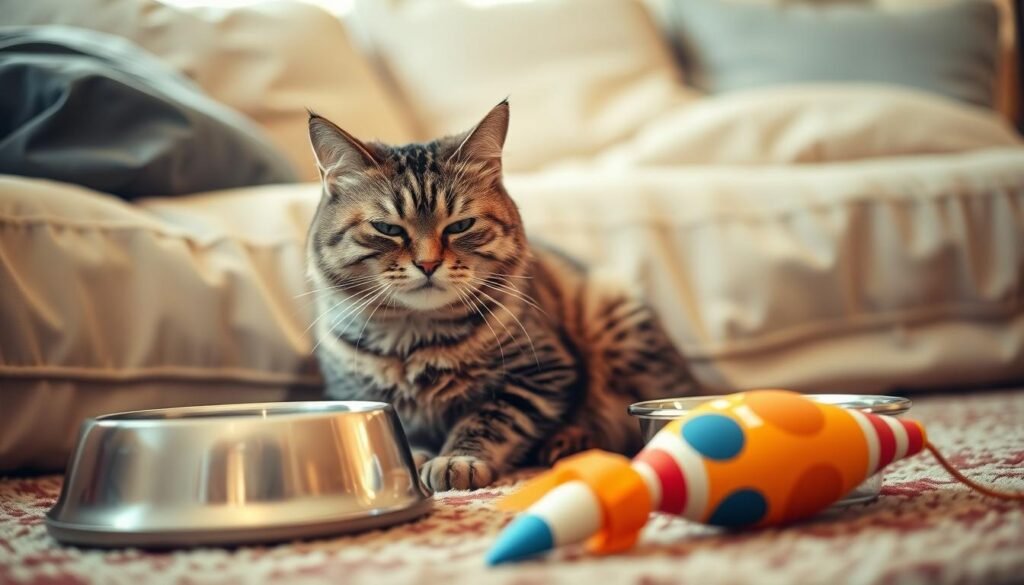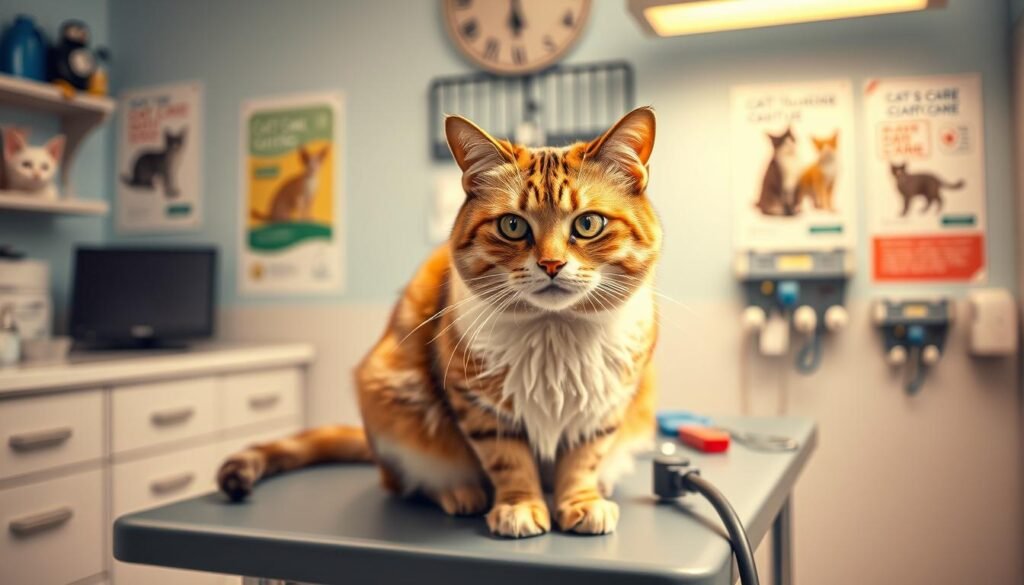Did you know about 70% of cat owners have noticed changes in their pets’ behavior due to whisker fatigue? Often, these signs are mistaken for normal cat behavior. Whisker fatigue, sometimes called whisker stress or sensory overload, happens when a cat’s sensitive whiskers get too stimulated. This can happen during simple activities like eating and exploring. It’s important to spot these symptoms early because it can really help your cat feel better.
Whiskers, also known as vibrissae, are very important for a cat. They help them understand their surroundings. But if they get overstimulated, it can cause problems. Cats might start grooming too much or show signs of anxiety. By learning about whisker fatigue and its signs, cat owners can take better care of their pets. This means making their living space more comfortable.
Key Takeaways
- Whisker fatigue occurs due to overstimulation of a cat’s sensitive whiskers.
- Symptoms may include food avoidance, irritability, and even aggression during mealtime.
- Using wider and shallower feeding bowls can help mitigate whisker stress.
- Frequent small meals may reduce instances of discomfort related to whisker fatigue.
- Veterinary advice is essential to differentiate whisker fatigue from other health issues.
What Is Whisker Fatigue?
Whisker fatigue, also known as whisker stress, happens when a cat’s sensitive whiskers get overloaded. These hairs are crucial for cats to figure out where they are and detect movement. But, touching surfaces like food bowls too much can cause stress or discomfort.
Cats with whisker fatigue might be cautious around their food bowls. They may knock food onto the floor to eat it or leave food behind even if they’re still hungry. Some cats become agitated with other pets or people. Deep food bowls are usually the reason, making eating a tough time for them.
To help cats with whisker fatigue, use bowls designed for their comfort. These bowls have flat surfaces or are wide enough so whiskers don’t touch the sides. The Americat Company, started by a woman in 2016, offers such products. Cat owners have seen their pets’ eating habits improve with these bowls.
Many cat owners don’t realize their pets suffer from whisker fatigue. Yet, it’s easy to fix with the right food and water dishes. Spotting the signs early makes for a happier, stress-free cat.
The Role of Whiskers in a Cat’s Life
Whiskers are very important for a cat. They act as key sensory tools. Each whisker is rooted deep in the cat’s skin, filled with special nerves. These nerves are crucial for making a cat aware of its surroundings. This helps the cat move around better.
Whiskers help cats detect slight changes around them. This is very useful for hunting, as it helps them sense prey movements. Whiskers are as wide as a cat’s body. So, cats use them to check if they can fit through tight spots, especially in low light.
A cat’s whiskers send information about the size, shape, and speed of objects near them. This constant flow of sensory data is key for hunting and avoiding dangers. Essentially, whiskers work like a high-tech system that helps cats interact with their environment.
Keeping whiskers healthy is crucial for a cat’s safety. Damaged or lost whiskers can show health problems. If whiskers aren’t taken care of, cats may feel lost and stressed. Whiskers are vital for a cat’s survival so they must be handled gently.
Causes of Whisker Fatigue in Cats
Whisker fatigue comes from daily activities, not sickness. Deep food bowls are a major cause of whisker fatigue. Cats have sensitive whiskers. Touching the bowl’s sides too much can bother them. This might make them eat differently or not at all.
Cats show their discomfort in their actions. They may spill food to avoid touching their bowl. Or they might not eat food from the bottom. This behavior shows how important their feeding area is. Too many cats or stress around them can make whisker fatigue worse. It can make them more anxious or easily upset.
Using shallow, wide bowls helps solve the problem. These bowls keep whiskers from touching the sides. That lets cats eat without trouble. Owners should watch how their cats eat. They should think about how their choice of bowl affects their cat’s comfort. Fixing the causes of whisker fatigue is key for a happy, stress-free mealtime.
| Type of Bowl | Whisker Contact | Behavioral Impact |
|---|---|---|
| Deep Food Bowls | High | Increased frustration, refusal to eat |
| Wide, Shallow Bowls | Low | Improved eating comfort, reduced stress |
Recognizing Whisker Fatigue Symptoms
Knowing the signs of whisker fatigue in cats is key to their health. They might show different symptoms like trouble eating. Catching these signs early helps make cats more comfortable and happy.
Changes in Eating Behavior
A big tell is a change in how a cat eats. They may get picky or not want to eat from their bowls at all. Some might even pull food out to eat it off the floor. This could mean they’re feeling discomfort, possibly from whisker fatigue. Seeing these changes is a hint for owners to check their cat’s eating space.
Visible Stress Signals
Cats might also show stress in clear ways. They could pause before entering tight spots or seem edgy around their space. If they get more irritable or mean, it might mean they’re stressed. Spotting these signs is important. It shows there may be a need to change their environment.

How Whisker Fatigue Affects Cat Behavior
Whisker fatigue can deeply affect how cats act. They might seem quieter or more upset than normal. Some may walk back and forth by their bowls, or seem stressed when they eat. If this happens, cats may try to eat off the floor instead of their bowls.
The problems caused by whisker fatigue don’t just affect eating. Cats might get aggressive with other pets during meal times. This is because the feeding area makes them uneasy. They might also groom themselves too much as a way to deal with stress. It’s important to watch these signs because they can harm a cat’s happiness.
| Behavior Changes | Possible Reactions |
|---|---|
| Pacing around food bowls | Indicates discomfort or hesitation to eat |
| Avoiding food despite hunger cues | Sign of stress and discomfort from bowls |
| Pawing food out to eat off the floor | Preference for a more comfortable eating surface |
| Increased aggression during mealtime | Response to perceived threats from other pets |
| Overgrooming behaviors | Likely a coping mechanism for stress |
Whisker Fatigue Symptoms to Watch For
Knowing how to spot whisker fatigue is key for a cat’s comfort. Several symptoms can show a cat is struggling with this issue. It’s important for cat owners to recognize these signs early.
Pacing Around Food Bowls
Cats pacing around their food bowls might feel discomfort. They might wait to eat until it feels safe to do so. This often happens because their whiskers touch the bowl’s edges, causing stress.
Unexplained Aggression
Sometimes, a cat may suddenly act aggressively. This could be due to the stress from whisker fatigue. They might get defensive to deal with their discomfort. Finding out why they’re acting this way can ease household tensions.
Overgrooming or Feline Barbering
Too much grooming can be a sign of whisker fatigue. It’s a stress relief strategy for them. If they overgroom, they might lose fur patches. Cat owners should watch for grooming changes and get advice when needed. For more info, check out this resource.

Preventive Measures Against Whisker Fatigue
Cat owners can make mealtimes better for their cats. They can prevent whisker fatigue by changing how they feed their pets. Simple changes can make a big difference in a cat’s happiness.
Using Shallow Bowls
Shallow food bowls are key to prevent whisker fatigue. They don’t annoy a cat’s whiskers like deep bowls do. Shallow bowls let cats eat comfortably without their whiskers touching the sides. Cats prefer these and eat more when using them. Brands like Americat Company offer great dishes that cats love.
Creating a Stress-Free Environment
Making a calm place for cats to eat is also important. A tidy and quiet space makes them feel safe. This, plus using the right bowls, improves their eating and mood. For more advice, check out this guide.
When to Consult a Veterinarian
It’s vital to know when your cat needs professional care for her well-being. Whisker fatigue isn’t usually serious, but its signs can look like other health issues. Watch your cat closely for any unusual behaviors. This may mean it’s time for a vet visit about whisker fatigue. Cats showing signs like not eating well or being more cranky may need a detailed check-up to find the real problem.
Identifying Other Health Issues
Whisker fatigue might hide other health problems. Issues like dental disease or stomach problems could cause similar behaviors, such as:
- Loss of appetite
- Excessive grooming, particularly around the face
- Pacing or vocalizing near food bowls
These behaviors could point to something more serious. A vet visit can give a full check-up. This helps figure out if it’s whisker fatigue or something else.
Professional Assessment and Guidance
Vets can give advice and ways to help with whisker fatigue. They might suggest:
- Using whisker-friendly feeding accessories
- Eating smaller meals more often
- Keeping an eye on the cat’s health for any early behavior changes
Keeping up with vet visits is key for a cat’s health. Dealing with whisker fatigue quickly helps avoid bigger problems from ignoring these signs of distress in cats.

| Signs of Whisker Fatigue | Possible Underlying Issues |
|---|---|
| Loss of appetite | Dental disease |
| Excessive grooming | Skin allergies |
| Pacing near food bowls | Gastrointestinal problems |
How to Help a Cat with Whisker Fatigue
Helping a cat with whisker fatigue means understanding their needs and making changes. By applying specific solutions, we can address whisker fatigue and reduce their stress.
Providing Whisker-Friendly Feeding Accessories
Using whisker-friendly feeding solutions is key. Deep bowls can cause discomfort for cats. Shallow, wide bowls prevent irritation to their whiskers.
Feedback shows cats prefer eating and drinking from these bowls, which boosts their food intake. The Americat Company has a stainless steel bowl stand perfect for your cat’s needs.
Monitoring Overall Health and Behavior
Watching your cat’s behavior and how they eat is important. Signs of distress include pacing, messy eating, or not finishing food. These could mean discomfort.
Noticing these changes helps reduce stress, making feeding time happier. For tips on spotting signs of whisker fatigue, see this helpful guide.
Conclusion
Whisker fatigue is crucial for a cat’s wellbeing. Some pet experts question it, but it’s all about noticing your cat’s discomfort. Signs include them being upset, eating less, and staying away from usual spots.
Creating a cat-friendly home helps a lot. Use bowls that are wide and not deep. Make sure their living area is peaceful. Adding fun toys can make their life better. Also, grooming their whiskers keeps them clean. This makes them comfy.
Knowing about whisker fatigue helps cat owners care better. By watching for signs, you can help your cat feel great. It makes the bond with your cat stronger. This way, cats can be both happy and healthy.